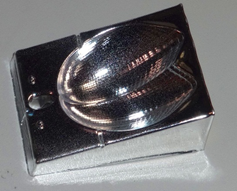The more pessimistic assessments of the global capacity to convert infrastructure to sustainable energy sources are, in some ways, the result of very limited thinking, of considering conversion in terms of existing technology. However, an ambitious effort in Europe, the iNSPiRe project, is offering an alternative way of looking at future prospects for infrastructure conversion and new construction that will rely on sustainable energy sources and groundbreaking new technologies — and 3D printing will most certainly play a major role.
Austrian lighting technology company Bartenbach has joined the team of iNSPiRe, a major, pan-European energy reduction initiative. They’re addressing the problem of excessive energy consumption by conceiving of and then producing what they refer to as “systemic renovation packages,” industrial products designed specifically to be retro-fitted into extant buildings in Europe. The renovation kits will include HVAC systems, pipes and ducts, energy generation systems, and lighting and shading systems.
The iNSPiRe project is a four-year-long, joint effort initiated by the European Union (EU), funded by the European Commission (EC) and the Framework Programmes for Research and Technological Development No. 7 (FP7, an EU/EC initiative). 24 participants from various fields are collaborating to refurbish existing buildings and transform them into nearly zero-energy structures. The overall goal of the project is to reduce energy consumption for lighting by at least 50% and to cut primary energy consumption in the buildings, post-war residential and tertiary structures, to below 50 kWh/m2 per year. In many regards, the iNSPiRe project is an ambitious, progressive laboratory.
“We are going to define a process for renovation…but we are also going to develop technologies and products that will be placed on the market,” says the iNSPiRe website.
The project emphasizes the importance of converting existing structures rather than undertaking entirely new construction.
Bartenbach’s role in the iNSPiRe project is exciting! They’ve developed a new optical component that is produced additively via 3D printing thanks to Dutch 3D printed optics company LUXeXceL. The optical component — called by its manufacturer “the RDB-Downlight Reflector,” or more poetically, “an office luminary” — reflects natural light and directs it to needed interior areas. The reflectors eliminate the need for illumination in hallways, on floors, and walls. Obviously, they save money and also reduce light pollution.
Each luminary is custom-made using 3D modeling and features multiple facets. The initial panel of 12 luminaries will take two weeks to print from a material LUXeXceL calls “LUX Opticlear.” Once printed, the luminaries are coated with a layer of aluminum, which partners with the faceting to optimize and direct reflection.
The completed reflector panel is destined for the Tosoni Office Building in Verona, Italy. Bartenbach envisions the luminary panels being applied parallel to buildings’ facades and also on ceilings. More exciting still, they will be working with other partners in the iNSPiRe project to integrate the reflectors with acoustic plus heating and cooling panels to create an overall “energy Kit 6, a multi-functional ceiling panel.” There are multiple possible configurations of the luminaries depending upon a given location, so integrating them with other components with differing functions is completely plausible.
This impressive project makes clear that 3D printing will be playing an integral role not only in the iNSPiRe collaboration, but in helping to, quite literally, illuminate a bright new path forward toward a sustainable, not-so-distant future.
What do you think about this initiative? Let us know if you think iNSPiRe is on the right track in the 3D Printed Reflector forum thread over at 3DPB.com.
Subscribe to Our Email Newsletter
Stay up-to-date on all the latest news from the 3D printing industry and receive information and offers from third party vendors.
You May Also Like
Gorilla Sports GE’s First 3D Printed Titanium Cast
How do you help a gorilla with a broken arm? Sounds like the start of a bad joke a zookeeper might tell, but it’s an actual dilemma recently faced by...
Nylon 3D Printed Parts Made More Functional with Coatings & Colors
Parts 3D printed from polyamide (PA, Nylon) 12 using powder bed fusion (PBF) are a mainstay in the additive manufacturing (AM) industry. While post-finishing processes have improved the porosity of...
$25M to Back Sintavia’s Largest Expansion of Metal 3D Printing Capacity Since 2019
Sintavia, the digital manufacturing company specializing in mission-critical parts for strategic sectors, announced a $25 million investment to increase its production capacity, the largest expansion to its operations since 2019....
Velo3D Initiates Public Offering in a Bid to Strengthen Financial Foundations and Drive Future Growth
Velo3D (NYSE: VLD) has been among a number of publicly traded 3D printing firms that have attempted to weather the current macroeconomic climate. After posting a challenging financial report for 2023,...


































